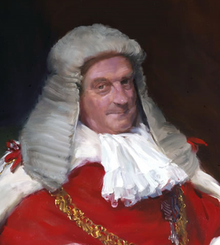Geoffrey Lane
|
The Right Honourable The Lord Lane AFC PC QC |
|
|---|---|

Lane in 1982, painted by George JD Bruce
|
|
| 12th Lord Chief Justice of England and Wales | |
|
In office 15 April 1980 – 27 April 1992 |
|
| Nominated by | The Lord Hailsham |
| Appointed by | Queen Elizabeth II |
| Preceded by | The Lord Widgery |
| Succeeded by | The Lord Taylor of Gosforth |
| Lord of Appeal in Ordinary | |
|
In office 1977–1980 |
|
| Appointed by | The Lord Hailsham |
| Lord Justice of the Court of Appeal of England and Wales | |
|
In office 1974–1977 |
|
| Judge of the Queen's Bench Division | |
|
In office 1969–1974 |
|
| Personal details | |
| Born |
Geoffrey Dawson Lane July 17, 1918 Derby |
| Died | August 22, 2005 (aged 87) |
| Resting place | St Ippolyts, Hertfordshire |
| Nationality | British |
| Education | Shrewsbury School |
| Alma mater | Trinity College, Cambridge |
| Civilian awards |
Knight Bachelor Life Peer |
| Military service | |
| Allegiance |
|
| Service/branch |
|
| Rank | Squadron Leader |
| Battles/wars |
D-Day Operation Market Garden |
| Military awards | Air Force Cross |
Geoffrey Dawson Lane, Baron Lane, AFC, PC, QC (17 July 1918 – 22 August 2005) was a British Judge who served as Lord Chief Justice of England from 1980 to 1992. The later part of his term was marred by a succession of disputed convictions. Lane's critics claimed that his refusal to believe that police evidence could be institutionally corrupt and his reluctance to overturn the verdict of a jury "represented a dangerous hindrance to justice". His failure to allow the appeal of the Birmingham Six in 1988 led to calls for his resignation following their successful appeal in 1991, and an editorial in The Times "urged him to go," while 140 MPs signed a House of Commons motion to that effect.
Lane was the son of a bank manager and was born in Derby. He attended Shrewsbury School and Trinity College, Cambridge where he graduated in the Classical and Law Triposes in 1939. He served as a pilot in the Royal Air Force during World War II, flying Wellington Bombers for 104 Squadron and later promoted to Squadron Leader to command 233 Squadron, which flew Dakota transport aircraft in D-Day and Operation Market Garden. He was awarded the Air Force Cross in 1943. He read for the bar when he was demobilised.
...
Wikipedia
